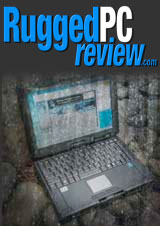|
|
Dell Latitude 5430 Rugged
Dell's full-size, high-performance, semi-rugged laptop is now lighter, more compact, and considerably more powerful
(by Conrad H. Blickenstorfer -- photography by Carol Cotton)
Share on:



The Dell Latitude 5430 Rugged was introduced on October 13, 2021 in a Dell Blog entry by Tom Tobul, VP and General Manager for Dell's Performance PCs portfolio of products that includes the Dell Rugged product line. Tobul described the new 5430 as a machine "designed for applications that requires excellent field durability combined with optimal performance." The Latitude 5430 Rugged is clearly the technologically updated and functionally enhanced successor of the existing Latitude 5420 Rugged.
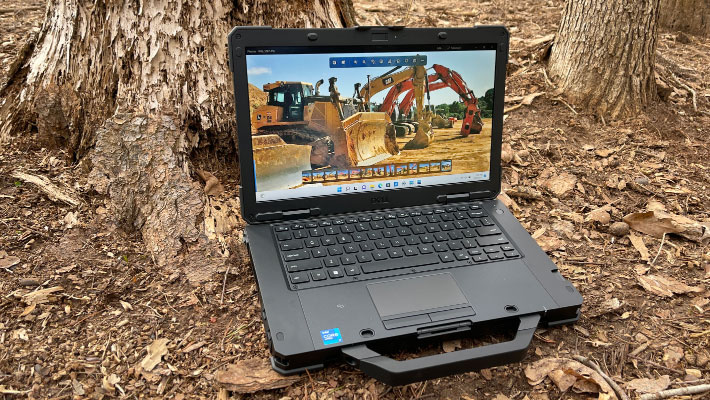
The new Latitude 5430 Rugged, however, is a lighter and more compact version of the predecessor 5420. How much lighter and how much more compact? Well, the 5430 starts at 4.35 pounds, over half a pound less than the 5420. And its 13.4 x 8.7 inch footprint is down 12%. That's a meaningful difference, and certainly appreciated by those who prefer to work and travel light. How did Dell do it? Hard to say, for the new model hasn't given up anything.
Dell Latitude 5430 Rugged positioning
Right upfront, just to avoid confusion: While Dell's two new heavy-duty machines have "Rugged" (the 5430) and "Rugged Extreme" (the 7330) right in their names, fact is that by commonly accepted nomenclature the 5430 is a semi-rugged laptop and the 7330 a fully rugged laptop. 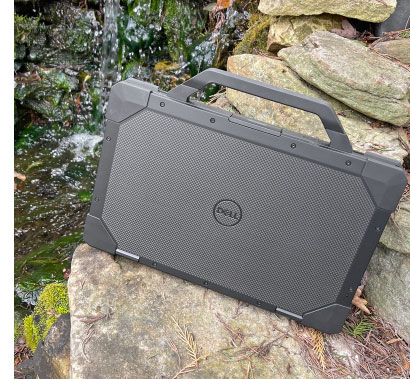 Yes, "semi-rugged" sounds somewhat awkward and it isn't clearly defined, but a better term simply hasn't come along. "Semi-rugged" is used to describe a device that's more durable than your average consumer laptop or even corporate notebook computer, but without going to extremes. What do we mean by extremes? Well, the Latitude 5430 Rugged starts at around US$1,700 whereas the Latitude 7330 Rugged Extreme starts at $4,100, more than twice as much. Yes, "semi-rugged" sounds somewhat awkward and it isn't clearly defined, but a better term simply hasn't come along. "Semi-rugged" is used to describe a device that's more durable than your average consumer laptop or even corporate notebook computer, but without going to extremes. What do we mean by extremes? Well, the Latitude 5430 Rugged starts at around US$1,700 whereas the Latitude 7330 Rugged Extreme starts at $4,100, more than twice as much.
You want a semi-rugged laptop if your computer spends more time outdoors and on the road than back in the office. Semi-ruggeds must be spill-proof because they may encounter rain, they must be able to handle vibration because they'll spend time in vehicles, and their screens must be viewable and usable outdoors and in bright sunshine. They must be fast and powerful enough to get all the work done, they must have enough battery life to make it through the day, they must have all the ports you need, and they must be light and handy enough to go anywhere.
|
|
Dell Latitude
|
5430 Rugged
|
5420 Rugged
|
|
|
Introduced
|
2021
|
2018
|
|
|
Standard display
|
14.0", 1920 x 1080 (157 ppi)
|
14.0", 1920 x 1080 (157 ppi)
|
|
|
Optional screen
|
Capacitive touch, 1100 nits
|
Capacitive touch 1000 nits
|
|
|
Dimensions
|
13.38 x 8.66 x 1.32 inches
|
13.66 x 9.65 x 1.3 inches
|
|
|
Discrete graphics
|
Yes; NVIDIA T500
|
Yes; Radeon
|
|
|
Weight
|
From 4.35 pounds
|
From 4.90 pounds
|
|
|
Processors
|
Intel 11th gen Core
|
Intel 6th/7th/8th gen Core
|
|
|
Battery
|
1 or 2 x 53.5Wh Li-Ion
|
1 or 2 x 51Wh Li-Ion
|
|
|
Memory
|
Max 32GB DDR4 3200MHz
|
Max 32GB DDR4 2400MHz
|
|
|
Max storage
|
2TB PCIe SSD
|
2TB PCIe SSD
|
|
|
Media bay
|
No
|
No
|
|
|
Windows Hello
|
Yes
|
Yes
|
|
|
USB Type-C
|
Yes
|
Yes
|
|
|
Thunderbolt 4
|
Yes
|
No
|
|
|
Sealing
|
IP53
|
IP52
|
|
|
Drop
|
3-foot operating
|
3-foot operating
|
|
|
Op. temp range
|
-20° to 145°F
|
-20° to 145°F
|
One look at the 5430 and you know this is no standard consumer laptop. The laptop looks tough and purposeful. It has an integrated handle to carry it around without needing to bring a bag along. All of the 5430's interface ports — and it has quite a few of those — have individual protective covers to guard against damage. This is a computer that you don't have to baby; it can take a bump or two. "Semi-ruggeds" are the SUVs of laptops. You can take them off-road, just not as much as dedicated military-grade vehicles.
New versus old, what does all this amount to? The big deal is the new technology under the hood. By now, the outgoing 5420 is three full Intel processor generations behind. While that makes the 5420 by no means obsolete, processor technology advances very quickly and Dell was in danger of being left behind by the competition, most of which is technologically up-to-date and at the state-of-the-art. The new 5430 fixes all that.
Compared to the 5430's predecessor, at first glance there seem just slight design changes here and there, but overall you can see this is still a semi-rugged Dell much like the previous one. And yet it has been changed and improved in many ways. The table above shows a comparison of some of the primary characteristics of new and old.

Now let's quickly recap Dell's history and experience in ruggedized laptops. Starting around 2007, Dell began offering ATG semi-rugged and XFR fully rugged notebooks ATG stood for "All Terrain Grade" and XFR for Xtreme Fully Rugged. The XFR models were originally made for Dell by Augmentix, a company which later became part of Dell. In early 2014, Dell replaced the XFR with the Latitude 12 Rugged Extreme convertible and the Latitude 14 Rugged Extreme laptop, and the ATG gave way to the Latitude 14 Rugged. That marked the start of Dell's semi-rugged "Latitude Rugged" and fully-rugged "Latitude Rugged Extreme" models.
Dell used to say that whereas the old ATG semi-rugged laptops were built "up" from standard Latitude commercial versions, the Latitude 14 Rugged models were built "down" from the Rugged Extreme line. As we shall see, that still seems to be the case. There is a big difference in look, design, weight and robustness between Dell's standard Latitude laptops for business and any of the rugged Latitude models. Rugged and Rugged Extreme labelled machines on the other hand, while very different in terms of environmental protection, look almost the same.
In terms of competition, the Dell Latitude 5430 Rugged is squarely aimed at Panasonic's Toughbook 55, Getac's S410, the Durabook S14I. There are also several Taiwan- and China-based OEMs whose durable and semi-ruggeds circulate under various brand names and sometimes also their own.
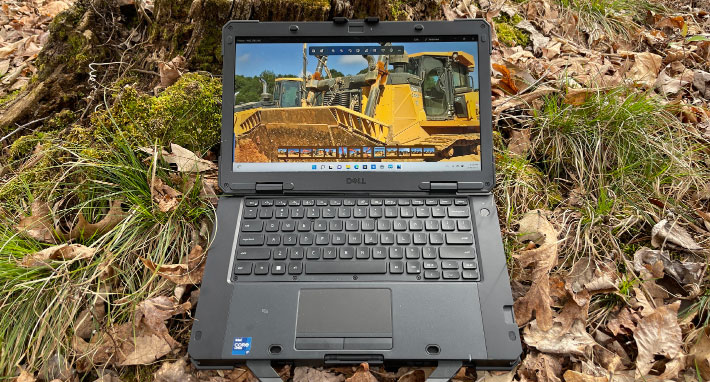
Design and construction
Dell has always done a fine job visually differentiating their rugged mobile computers from more consumer and enterprise oriented platforms, all the while creating a crisp and elegant look. Dell rugged gear isn't generally as overtly aggressive as some of the competition's — the company prefers to emphasize understated competence instead. But the Dell Rugged and Rugged Extreme laptops also feel tough and solid, leaving no doubt that these are heavy-duty computing machines that can do what no standard consumer or even business laptop could tackle.
But let's take a closer look at the Dell Latitude 5430 Rugged. Below you can see the top and all four sides of the machine:
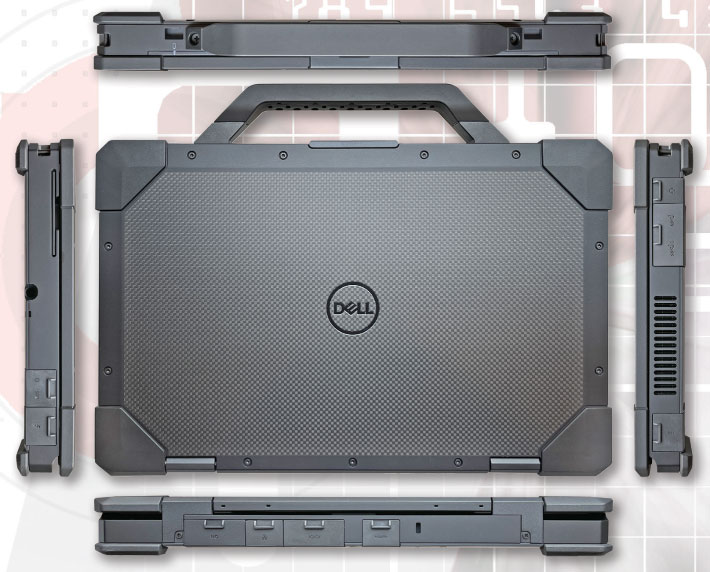
Ports and connectivity are all around the housing, excluding the front which is where the optional sturdy, well-designed fixed-mount carry handle goes. To guard against physical damage, all ports are located behind protective doors. Those port covers are simpler than on the 7330 Rugged Extreme and they are not designed to seal against dust and liquids. Instead of the 7330's port covers with spring-loaded levers and locking sliders, the ones on the 5430 need to be properly seated and then pushed into place, which requires a bit more attention than we'd like.
As far as wired connectivity goes, the 5430 Rugged offers plenty.
Along the backside (shown below with protective port covers removed for better viewing) are from left to right:
- An optional I/O bay with USB 3.0 port (OR native serial OR Fischer USB 3.0)
- An RJ45 gigabit LAN jack
- A DB9 RS232 serial port (OR DisPlayPort OR DB15 VGA port)
- A standard HDMI port to connect a monitor
- A Kensington lock slot

On the left side (shown below, again with protective port covers removed) you can see from left to right:
- A Thunderbolt 4/USB 3.2 Gen 2 Type-C port with PowerDelivery 3.0
- A USB 3.2 Gen 1 port with PowerShare
- A USB 3.2 Gen 1 port
- A 3.5mm combo headphone & microphone jack

On the right side (shown below, with protective port covers removed) you can see from left to right:
- An optional Smart Card reader
- An optional stylus slot
- A SDXC card slot
- A Nano SIM card slot
- An optional Thunderbolt 4/USB 3.2 Gen 2 Type-C port with PowerDelivery 3.0

What all of that means is that with the new 5430 Rugged Dell now has a semi-rugged laptop with completely updated technology under the hood. It is a lighter and more compact version of the predecessor 5420 Rugged.
A look inside the Dell 5430 Rugged
Opening up a Dell Latitude 5430 is an experience. Not because it
is particularly difficult — undo two dozen small Phillips screws and carefully disconnect a couple of (short) cable strands — but because of what you find inside. 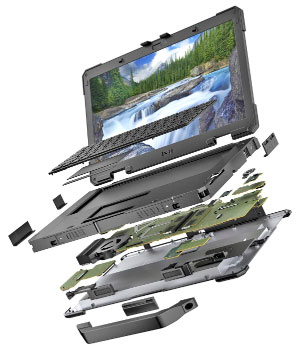 In an era where most laptop housings are slender, fragile, and often downright cheap, this very reasonably priced semi-rugged Dell surprises with an all-magnesium aluminum (the addition of magnesium to aluminum increases the strength of the metal) housing. In an era where most laptop housings are slender, fragile, and often downright cheap, this very reasonably priced semi-rugged Dell surprises with an all-magnesium aluminum (the addition of magnesium to aluminum increases the strength of the metal) housing.
And it's not just a box with a couple of boards mounted inside. Dell went all out here to design this machine as an integral whole. Both the front and the back half of the case are designed to accommodate every part of the overall computer.
Nothing is just tacked on. Every wire has a wire guide, every module is securely mounted in its place, and every ribbon cable seems individually designed to fit just so. What needs to be shielded is shielded with the proper material. Dozens of small 2D barcodes mark purpose, identity and origin of every component, and wherever Dell's designers and engineers saw an opportunity to bake in some more functionality, some better cooling, some extra rigidity, some small weight saving into the case and everything else, they did it. The degree of detail is dizzying.
This attention to detail is everywhere. Rugged computers must have those protective covers over I/O ports to keep them from getting damaged and to keep dust and water from getting inside the computer. That's often done with just a couple of rubber plugs. This Dell laptop, on the other hand, has NINE individual protective covers, each a different design, each separately mounted, each able to move just the right amount, and each perfectly integrated into the metal housing.
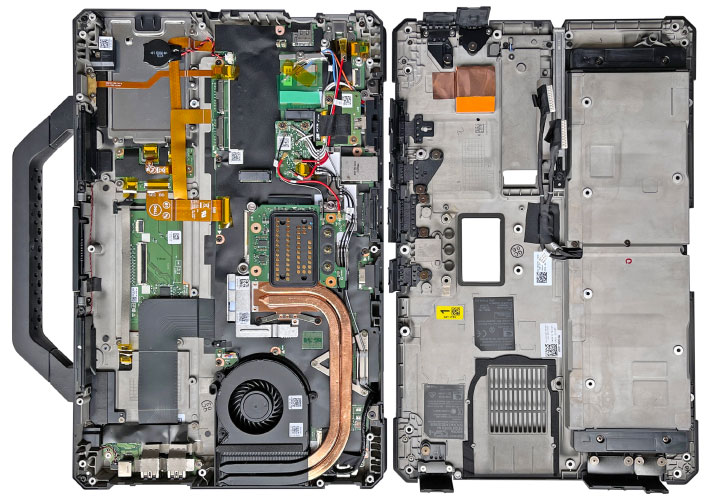
The thermal design is equally impressive. As is generally the case these days with semi-rugged and rugged laptops, the 5430 has a small fan. It also has two prominent copper heat pipes that channel the heat generated by the processor and other electronics to the heat exchanger cooled by the fan. Between that and the solid metal case of the 5430, overheating should never be an issue. But just to make extra-sure, wherever there is a small component that might get hot, Dell applied a thermal strip that then conducts the heat on to a metal heatsink.
The images below were taken while the 5430 was running performance benchmarks with our FLIR ONE Pro thermal camera that visually depicts surface temperature.

A fan, of course, requires an air intake and an air exhaust, which means openings to the inside of the computer. That is an issue for fully rugged laptops which these days generally carry an IP65 rating, meaning they are pretty much fully water-proof. Fully-rugged designs do that by encapsulating a water-proof fan so that it technically is outside the housing. The 5430, though it's called the "5430 Rugged" is technically a semi-rugged with an IP53 ingress protection rating, as is currently pretty much standard for semi-ruggeds. Look at the fan in the image and you'll see that it is NOT separated from the electronics inside. The only protection is a thin neoprene seal to provide a bit of a barrier against liquids getting in.
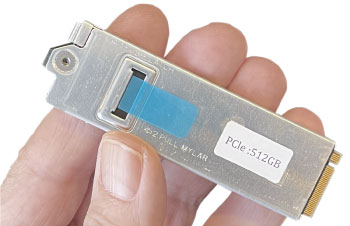 That is one of the big differences between the Latitude 5430 Rugged and the Latitude 7330 Rugged Extreme. Dell probably COULD have encapsulated the fan in the 5430 as well, but they had to draw the line between semi and fully rugged somewhere. That is one of the big differences between the Latitude 5430 Rugged and the Latitude 7330 Rugged Extreme. Dell probably COULD have encapsulated the fan in the 5430 as well, but they had to draw the line between semi and fully rugged somewhere.
And speaking of that line between semi-rugged and fully rugged, the port covers are another major difference between the 5430 and the 7330. The 5430's are made of hard rubber and mostly guard against physical damage of the ports. The 7330's are significantly more elaborate and also guard against liquids getting inside.
The image to the right shows the 5430's PCIe NVMe storage module. The space saved by dropping the old 2-1/2 inch mass storage bays in these kinds of laptops in favor of smaller and much faster PCIe NVMe storage is substantial. And it's also much easier to quickly remove these storage modules, which has become a security requirement by many agencies and organzations.
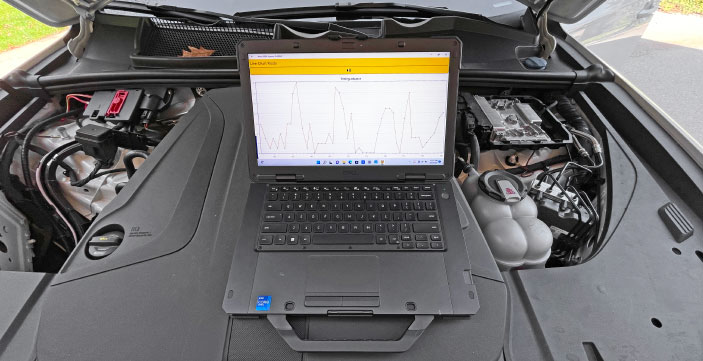
Keyboard and hardware controls
A solid, well-designed and well-functioning keyboard is crucial in a laptop. If the keyboard isn't up to par, one might as well use a tablet. Dell, of course, has decades's worth of experience in getting laptop keyboards just right, and that shows in the Latitude 5430 Rugged.
What customers are getting here is island-style keyboard perfection. That starts with a "full-scale" layout of the all important alpha keys. The distance from the center of the letter Q on the upper lefthand and the center of the letter P on the upper righthand of the alphabet key layout is exactly 6.75 inches. That's crucial for touch typists because muscle memory expects each key to be in its right place, and even small deviations can throw typing speed and accuracy off. Even hunt & peckers benefit from that. The keys are a tiny bit concave for optimal touch. Key travel is nice and short and provides perfect tactile feedback.
Letters and symbols are white on black and centered on the keys. Font and size are elegant and just the right size. As is usually the case, the F1 through F12 keys also offer shifted functions that include volume, brightness, and other common tasks.
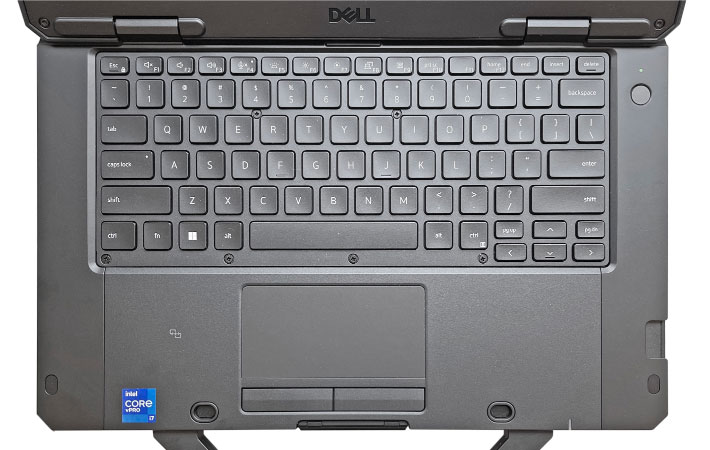
The 5430 has a 4 x 2 inch capacitive touchpad with separate left and right mouseclick tabs below it. The pad area is slightly recessed so that fingers easily sense the perimeter of the pad. The pad surface has a little bit too much stiction for our taste. "Stiction" is defined as "the friction that tends to prevent stationary surfaces from being set in motion." The stationary surface here is the finger, and it takes a bit of force to overcome friction and get the finger moving, rather than just glide away.
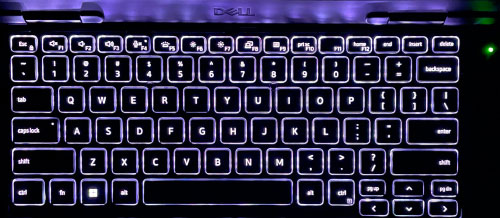 Our review unit had the optional internal-sealed RGB backlight keyboard. The backlight is controlled by one of the function key. Tapping that key toggles the backlight on/off and through three levels of intensity. The comprehensive Dell Rugged Control Center lets you set the keyboard backlight to red, green, blue, white or one of two custom colors. You can also set the default brightness of the keyboard backlight and how long the keyboard should remain backlit when plugged in and when on battery. Our review unit had the optional internal-sealed RGB backlight keyboard. The backlight is controlled by one of the function key. Tapping that key toggles the backlight on/off and through three levels of intensity. The comprehensive Dell Rugged Control Center lets you set the keyboard backlight to red, green, blue, white or one of two custom colors. You can also set the default brightness of the keyboard backlight and how long the keyboard should remain backlit when plugged in and when on battery.
Some keyboard backlights irritate with the illumination bleeding out around the keys in the dark. That's not an issue with the 5430's backlit keyboard; the backlight is designed so that it nicely outlines each key, but does not bleed out beyond.
Performance: 11th generation "Tiger Lake" processor technology
Dell sells tens of millions of laptops every year. That sort of volume allows the company to stay on top of the latest technological advances and developments, and quickly make the latest tech available to their customers. One would expect that to be the case for Dell's rugged gear as well, but that's not always so. Of the major rugged laptop makers, Dell was actually the last to upgrade from the 8th generation of Intel Core processors to the 11th generation, which for a variety of reason has become milestone for high performance rugged laptops and tablets.
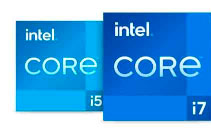 As of this writing (mid March 2022), of the semi-rugged laptop competition, the Panasonic Toughbook 55, Durabook S14I, and Getac S410 are all built around Intel's 11th generation of Core processors. Intel's 12th generation — Alder Lake — is already on the horizon, but so far hasn't found its way into rugged laptops. As of this writing (mid March 2022), of the semi-rugged laptop competition, the Panasonic Toughbook 55, Durabook S14I, and Getac S410 are all built around Intel's 11th generation of Core processors. Intel's 12th generation — Alder Lake — is already on the horizon, but so far hasn't found its way into rugged laptops.
While Dell is late to the 11th gen party, there really haven't been drastic changes in the last few generations of Intel's Core processors. It's difficult to make gates (really transistors) smaller and smaller, and Intel has spent much time fine-tuning and optimizing their chips over the past few years. There have been milestones such as making mobile quad-core chips available in the "Coffee Lake" 8th generation. And now we're seeing another in the "Tiger Lake" 11th generation used in all the major semi-rugged laptops (we'll get into the why that is).
As is, below is a list of the processor options available for the Dell 5430 (to view the full Intel spec table for these three CPUs, see here):
|
2022 Dell Latitude 5430 Rugged: Available Intel Core processor options
|
|
Available CPUs
|
Intel Core i7
|
Intel Core i5
|
Intel Core i5
|
|
Model
|
1185G7
|
1145G7
|
1135G7
|
|
Cores/Threads
|
4/8
|
4/8
|
4/8
|
|
Base Clock Speed
|
1.20 GHz
|
1.10 GHz
|
0.90 GHz
|
|
Turbo Speed
|
4.80 GHz
|
4.40 GHz
|
4.20 GHz
|
|
TDP-up
|
28 watts, 3.00GHz
|
28 watts, 2.60GHz
|
28 watts, 2.40GHz
|
|
TDP-down
|
12 watts, 1.20GHz
|
12 watts, 1.10GHz
|
12 watts, 0.90GHz
|
|
Smart Cache
|
12MB
|
8MB
|
8MB
|
|
Integrated graphics
|
Iris Xe
|
Iris Xe
|
Iris Xe
|
|
Graphics max speed
|
1.35 GHz
|
1.30 GHz
|
1.30 GHz
|
|
Graphics Execution Units
|
96
|
80
|
80
|
|
Relative CPU cost
|
1.53
|
1.10
|
1.10
|
|
Intel Stable Image Platform Program
|
Yes
|
Yes
|
No
|
|
Intel TSX-NI
|
Yes
|
Yes
|
No
|
|
Intel Trusted Execution
|
Yes
|
Yes
|
No
|
|
Intel vPro
|
Yes
|
Yes
|
No
|
The top processor option for the Dell Latitude 5430 Rugged is the Intel Core i7-1185G7 (installed in our review unit). This high-end chip offers the highest maximum turbo frequency as well as the highest frequencies at the 28 watt and 12 watt TDP-Up and TDP-down settings. Dell skips the i7-1165G7 that most of the competition offers, and so next in line are two Core i5 chips that have only 8MB instead of 12MB SmartCache, fewer graphics execution units, as well as small clock frequency and included Intel technology differences. Dell also foregoes offering a low-end i3 chip. We don't miss that as those only come with just two cores instead of four, and also without Intel's more powerful Iris Xe graphics.
What may make a difference in certain applications is the availability of four special Intel technologies (vPro, TME, SIPP, and Trusted Execution) included in the i7-1185G7 and i5-1145G7, but not in the low-end i5-1135G7. Here's what that means:
- The extra security and manageability capabilities of vPro, especially, are required in many enterprise deployments.
- TME (Total Memory Encryption) ensures that all memory accessed from the CPU is encrypted, including customer credentials, encryption keys, and other IP or personal information on the external memory bus.
- SIPP (Stable Image Platform Program) allows deployment of standardized, stable image PC platforms for at least 15 months, and
- Trusted Execution technology provides security capabilities such as measured launch and protected execution, and may thus also be an enterprise requirement.
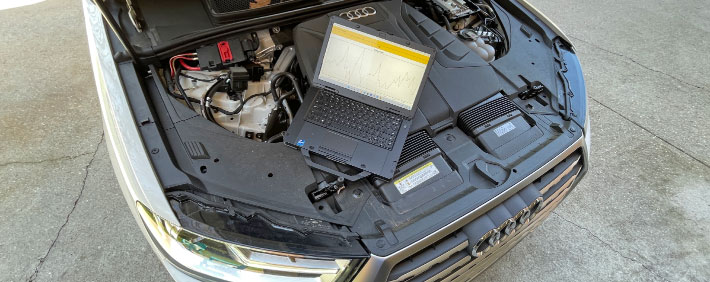
To see what kind of performance the new Dell 5430 Rugged delivers, we ran our standard benchmark suites, Passmark Software's PerformanceTest 6.1 and 9.0 that include dozens of tests covering CPU, 2D graphics, 3D graphics, memory, and disk and then computes scores for each category and an overall PassMark scores. We also ran our old standby, CrystalMark, that provides valuable clues as to overall single core performance. We're also showing results of three other major benchmark suites: PC Mark 10, GeekBench 5 and one of the most often used 3DMark graphics benchmarks, Time Spy.
To show where the 5430 Rugged stands in terms of overall performance, the below table also includes results of its 5424 predecessor that we tested in 2018, as well as those of the semi-rugged direct competition.
The results are as follows:
|
Dell Latitude 5430 Rugged Benchmarks and Comparisons
|
|
Manufacturer
|
Dell
|
Dell
|
Durabook
|
Getac
|
Panasonic
|
|
Model
|
5430 Rugged
|
5424 Rugged
|
DURABOOK S14I
|
S410
|
TOUGHBOOK 55
|
|
Year tested
|
2022
|
2018
|
2021
|
2021
|
2021
|
|
CPU Type: Intel
|
Core i7
|
Core i5
|
Core i7
|
Core i7
|
Core i7
|
|
CPU Model and generation
|
1185G7 (11th)
|
8350U (8th)
|
1165G7 (11th)
|
1185G7 (11th)
|
1185G7 (11th)
|
|
Thermal Design Power (TDP)
|
12/28 watts
|
15 watts
|
12/28 watts
|
12/28 watts
|
12/28 watts
|
|
BatteryMon minimum draw
|
2.0 watts
|
4.2 watts
|
5.5 watts
|
3.8 watts
|
3.3 watts
|
|
PassMark 6.1
|
9,848.3
|
5,187.8
|
10,338,7
|
8,292.7
|
5,792.3
|
|
PassMark 9.0
|
5,853.8
|
3,665.6
|
5,164.5
|
5,637.2
|
4,964.8
|
|
CrystalMark
|
562,890
|
281,820
|
455,646
|
488,622
|
503,390
|
|
PCMark 10
|
5,217
|
NA
|
4,570
|
4,876
|
4,904
|
|
3DMark Time Spy
|
1,529
|
NA
|
1,040
|
1,579
|
1,160
|
|
GeekBench 5 Single Core
|
1,566
|
NA
|
1,496
|
1,545
|
1,484
|
|
GeekBench 5 Multi Core
|
5,232
|
NA
|
3,640
|
5,225
|
4,560
|
|
GeekBench 5 Open CL
|
14,890
|
NA
|
12,350
|
16,653
|
12,745
|
The results are convincing. The new Dell 5430 Rugged is MUCH faster than its by now four years old 5424 Rugged predecessor. And though Dell is late to the 11th gen party, as the newest currently available design it's also overall the quickest of the semi-rugged laptop market leaders. Don't read too much into that, though; all semi-ruggeds based on Intel 11th gen processor technology are VERY fast. Small differences here and there may come from slightly different components or from system configuration and the manufacturer's CPU tuning. Overall, the competition here is fierce and all the major players now use the latest tech. That said, kudos to Dell for tweaking everything to the max.
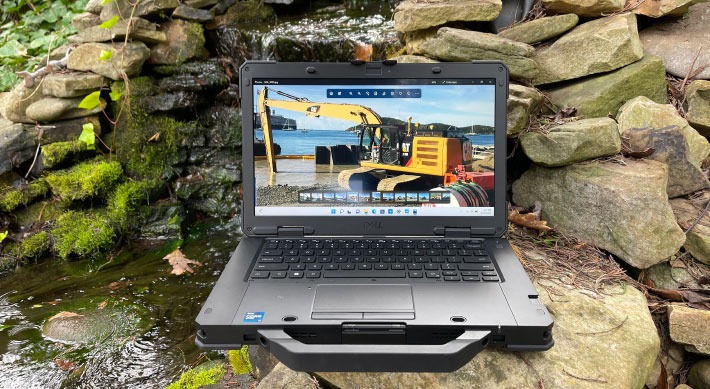
We should mention here something that generally gets little mention in reviews, and that's the difference in performance when a system is plugged in and when it is running on battery.
Benchmark testing is almost always done with computers plugged in. This guarantees consistent results, keep systems from running out of power during a benchmark, and also shows the absolute maximum performance a user can expect from a laptop. 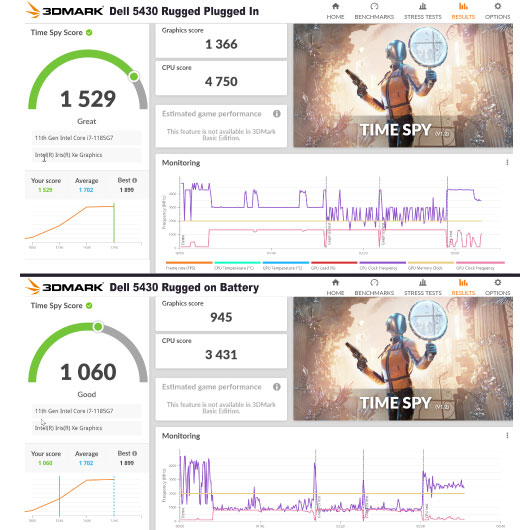 Many benchmark tests actually display a warning when one attempts to launch them while on battery. Many benchmark tests actually display a warning when one attempts to launch them while on battery.
There are, however, implications of running benchmarks only with systems plugged in. Windows has several settings that affect performance. There are the "Best Performance" and "Best Power Economy" settings in the Windows 10 Toolbar. There are various areas in Windows Settings affecting performance where one value is selected for battery and another for when the system is plugged in.
Starting with the 11th generation of Core processors, Intel provided their manufacturing customers with the flexibility to design systems to their specific targets and needs. This included "tuning" performance and economy via power modes to a much larger extent than with earlier Core processors. As a result, we are now seeing in our testing significant difference in how rugged systems are under various operating conditions. Specifically, some manufacturers tune their system for nearly equal performance when plugged in and when on battery. Others emphasize performance when plugged in, and battery life when on battery. Yet others may feel that there should be maximum performance in the field, even at the cost of battery life.
What we found with the Dell Latitude 5430 Rugged is that Dell tuned the systems to run at maximum performance when plugged in, but clearly favoring economy when on battery. By how much? Looking at all the tests we ran, the 5430 Rugged is 40 to 50% faster when plugged in than on battery. The graphs above show a representative example, the 3DMark Time Spy benchmark. Note the large performance difference, and then compare the CPU frequency during the test. Manufacturers use the Intel Dynamic Tuning Technology (DTT) to set performance variables PL1, PL2 and Tau for different modes of operation. What this means is not only that machines may run slower on battery in the field than plugged in back in the office, but also that plugged-in benchmarks do not tell the whole story.
Power draw and battery life
Battery life is one of the most important metrics in a semi-rugged laptop. It can make or break sales. As a result, competition is fierce and the bar for what is acceptable battery life is getting higher and higher. Weight matters more in semi-ruggeds than in fully-rugged laptops, and that mandates a careful balance between weight and on-board battery power.
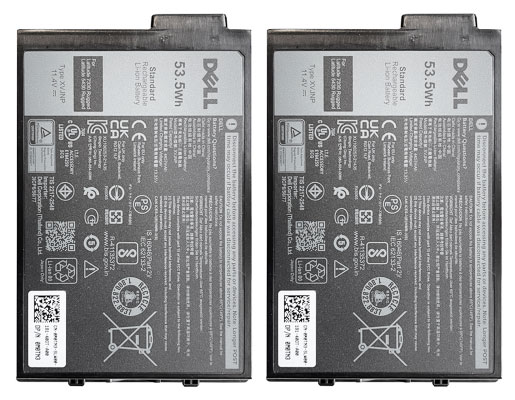 Even though there has been substantial progress in battery energy density, batteries still add weight at a time where customers want their semi-ruggeds as light and handy as possible. The original Dell Latitude 14 Rugged came with a 65 watt-hour or an optional 97 watt-hour battery and had a starting weight of 6.3 pounds. The follow-up Latitude 7420 Rugged switched to the increasingly popular dual battery approach that allows for hot-swapping of batteries and also made for a lower "starting weight" with just one battery; a minimally equipped 5420 started at just 4.9 pounds. The new 5430 uses the same approach. It comes with one or two 53.5 watt-hour batteries, so you can get an impressive 107 watt-hours. Minimally equipped, weight starts at a, for this class, very low 4.35 pounds. Even though there has been substantial progress in battery energy density, batteries still add weight at a time where customers want their semi-ruggeds as light and handy as possible. The original Dell Latitude 14 Rugged came with a 65 watt-hour or an optional 97 watt-hour battery and had a starting weight of 6.3 pounds. The follow-up Latitude 7420 Rugged switched to the increasingly popular dual battery approach that allows for hot-swapping of batteries and also made for a lower "starting weight" with just one battery; a minimally equipped 5420 started at just 4.9 pounds. The new 5430 uses the same approach. It comes with one or two 53.5 watt-hour batteries, so you can get an impressive 107 watt-hours. Minimally equipped, weight starts at a, for this class, very low 4.35 pounds.
How does it compare to the semi-rugged competition? Well, Panasonic offers one or two 68 watt-hour batteries in their Toughbook 55 that starts at 4.6 pounds. Durabook's S14I can accommodate one or two 50.8 watt-hour batteries and starts at 5.1 pounds. And Getac's S410 also comes with either one or two 74.5 watt-hour batteries, but also has room for a 46.6 watt-hour multimedia bay battery. The S410 starts at 5.25 pounds.
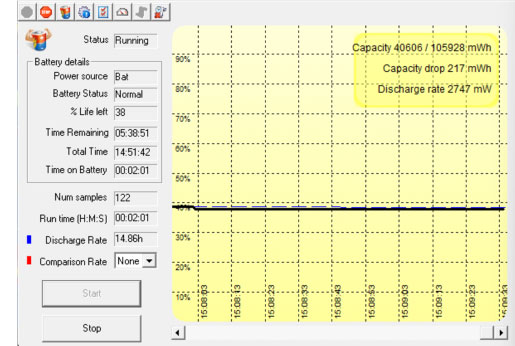 We tested power draw of the Latitude 5430 Rugged by running our standard BatteryMon benchmark. With the Windows 11 Power Mode set to "Best power efficiency," "Battery Saver" in the Windows task bar clicked on, and the display backlight on its lowest setting, we saw a minimum of about 2.0 watts. That's theoretically good for 26.75 hours with one battery and a whopping 53.5 hours with two batteries. We tested power draw of the Latitude 5430 Rugged by running our standard BatteryMon benchmark. With the Windows 11 Power Mode set to "Best power efficiency," "Battery Saver" in the Windows task bar clicked on, and the display backlight on its lowest setting, we saw a minimum of about 2.0 watts. That's theoretically good for 26.75 hours with one battery and a whopping 53.5 hours with two batteries.
With the backlight set to roughly 50% for comfortable indoor viewing, we saw a minimum of 2.6 watts, theoretically good for 20.6 hours with one battery and 41.2 hours with two. And with the backlight set to maximum brightness, power draw rose to a minimum of 6.6 watts, theoretically good for 8.1 hours with one battery and 16.2 hours with both.
|
Dell Latitude 5430 Rugged BatteryMon Power Draws (at idle)
|
|
Backlight level
|
Darkest
|
50%
|
Brightest
|
|
Max Battery
|
2.0 watts (53.5 hrs.)
|
2.6 watts (41.2 hrs.)
|
6.6 watts (16.2 hrs.)
|
|
Max Performance
|
2.9 watts (36.2 hrs.)
|
3.6 watts (29.2 hrs.)
|
7.1 watts (14.8 hrs.)
|
We then switched the Windows Power mode set to "Best Performance" and "Battery Saver" in the Windows task bar turned off." That way, with the display backlight set to its lowest setting, we saw a minimum of about 2.9 watts. With the backlight set to 50% for comfortable indoor viewing, we recorded 3.6 watts. And with the backlight set to maximum brightness, power draw rose to just 7.1 watts, still theoretically good for 7.4 hours with one battery and 14.8 hours with both.
Real-world mileage will of course vary, as always. Minimum draw in a test lab is not an accurate predictor of actual battery life. Intel's Core processors have become very good at conserving power, to the extent where their recorded "idle" draw is actually often less than that of many Atom processors. Under full load, of course, the powerful Core chip will draw more than the limited Atom CPU.
That's why we also ran the PCMark 10 Battery benchmark. That very comprehensive benchmark continuously runs, in its "Modern Office" mode, everyday applications and types of work at a standardized 200 nits backlight until battery power runs out. Here, the 5430 managed 14:51 hours with two batteries. That is quite impressive.
Bottomline is that between the advanced power savings technologies built into Intel's 11th gen processors, Microsoft's various power conservation modes in Windows 11, and Dell's engineering and thermal management, we're seeing power draws way lower than in the past and almost unprecedented battery life
Bright and very good 14-inch display
The Dell 5430 Rugged's 14.0-inch display is more than large enough to allow working without squinting. Default resolution is 1920 x 1080 pixel. For many years, most semi- and fully rugged laptops came with lower resolution 1366 x 768 displays and full HD wasn't even available for many of them. We're glad those days are gone. The display offers 157 pixel per inch, not "retina" territory but sharp and clear enough.
Touch isn't really needed with a laptop, but with Windows 10 and now Windows it's increasingly useful and a good thing to have. The Dell 5430's default display doesn't have touch. A brighter outdoor-viewable display option does come with capacitive multi-touch.
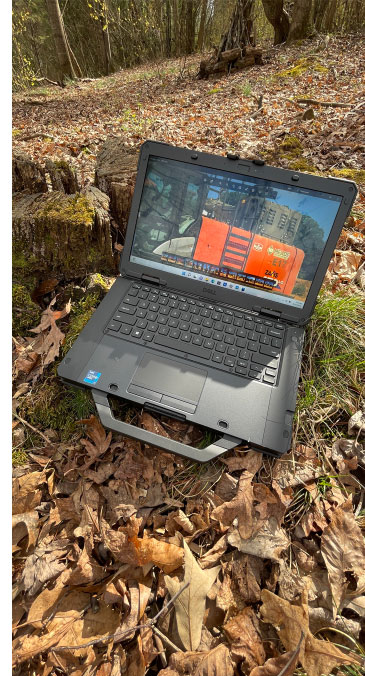 The Dell 5430 display's 16:9 aspect ratio gives the laptop a contemporary look; the older squarish-looking 4:3 aspect ratio displays that used to be prevalent in rugged and semi-rugged notebooks are pretty much gone now. Interestingly, while the semi-rugged 5430 and the fully rugged 7330 are almost identical in look and size, the 5430 has a 14-inch screen and the 7330 one that's slightly smaller at 13.3-inch. The rationale for this we can think of is that with the compact form factor and footprint of the new 7330, there might not have been enough of a bezel to adequately protect a larger 14-inch panel from damage. The Dell 5430 display's 16:9 aspect ratio gives the laptop a contemporary look; the older squarish-looking 4:3 aspect ratio displays that used to be prevalent in rugged and semi-rugged notebooks are pretty much gone now. Interestingly, while the semi-rugged 5430 and the fully rugged 7330 are almost identical in look and size, the 5430 has a 14-inch screen and the 7330 one that's slightly smaller at 13.3-inch. The rationale for this we can think of is that with the compact form factor and footprint of the new 7330, there might not have been enough of a bezel to adequately protect a larger 14-inch panel from damage.
Display size, of course, isn't everything. Semi-rugged notebooks like the Dell 5430 may see a lot of outdoor duty or they may be mounted in vehicles. That means lots of reflections and often direct sunlight. Standard transmissive LCD displays tend to wash out in daylight, and that's why good sunlight-readability has become a selling point with rugged notebooks. The currently most popular way of making a notebook screen readable outdoors combines various optical treatments to control internal reflection with a strong backlight.
A few words about screen brightness here: A standard notebook backlight is in the 200 nits luminance range (1 nit = 1 candela per square meter) range. Some manufacturers up the brightness in their business products, usually into the 300-400 nits range. Industrial monitors used outdoors generally have 400 to 500 nits. High end rugged notebooks offer anywhere from 500 to over 1,000 nits, with premium ones such as the fully-rugged Dell 7330 offering as much as 1,400 nits. The Dell 5430 comes standard with 400 nits display — brighter than a standard consumer laptop, but not bright enough for a lot of outdoor use. And that's why Dell offers an optional 1100 nits touch display. Our test unit had that optional display, though we measured it at just 965 nits in with our own luminance testing equipment.
Very strong backlights, of course, affect battery life. Some of Dell's competitors have dedicated "sunlight readable" buttons to toggle super-brightness on and off.  The Dell 5430 doesn't have such a button. So when working with a 5430 with the optional high-bright display in broad daylight, keep an eye on brightness setting. It can make a big difference in battery life. The Dell 5430 doesn't have such a button. So when working with a 5430 with the optional high-bright display in broad daylight, keep an eye on brightness setting. It can make a big difference in battery life.
The 5430 display is what we'd describe as a "semi-gloss" screen. Matte displays are best for eliminating distracting reflections, but they tend to make displays look milky. Full gloss displays, which are pretty much the standard in consumer and business laptops these days, "pop" nicely, but they are prone to strong reflections outdoors. Semi-gloss screens still have some reflections but they are far more muted than those of most consumer laptops and tablets.
Unlike some displays that are fingerprint magnets, the 5430 display is remarkably immune to collecting pesky smudges and fingerprints that quickly cover almost all glossy displays.
Viewing angles are important. Both horizontal and vertical viewing angles of the Dell 5430 screen are very good, without any color shifts even when viewed at extreme angles.
Thunderbolt 4
Almost every new laptop or tablet has a USB-C port these days. Unlike the original USB Type A port where the plug would only go in one way, the smaller USB-C ports work no matter which way you plug it in. Not every USB-C port, however, is the same — it depends on what version and generation of the USB standard it supports.
To make matters more confusing yet, a USB-C port may also be a Thunderbolt 4 port. Thunderbolt started as a joint effort between Intel and Apple, combining the PCI Express and DisplayPort signals. The latest version, Thunderbolt 4, uses the USB-C connector, supports charging upstream and downstream, USB 4 with very fast data transfer (up to 40 Gbit/s), as well as dual 4K displays. And the Dell Latitude 5430 Rugged has one — or, optionally, two — of those Thunderbolt 4 ports with USB-C connectors.
We gave the Dell Latitude 5430 Rugged's USB-C Thunderbolt 4 port a workout and here's what we could do:
- Drive a 2nd screen via USB-C to DisplayPort cable
- Drive a 2nd screen via USB-C to HDMI cable
- Do very fast file transfers (note: you must use special USB4 40Gbps cables)
- Drive and power an external DVD reader
- Use a USB key or card reader via USB-A to USB-C adapter
- Drive a mouse and/or keyboard
- Charge a phone or tablet
Intel emphasizes that Thunderbolt 4 offers tablet and laptop users a true "one wire" solution. Here's the way that's envisioned: bring your laptop to the office and plug it into an external Thunderbolt 4 dock. That dock will then charge the laptop upstream and your phone(s) downstream, and also support a mouse, keyboard, USB keys, DVD drives, one or two external screens and whatever else you'd like to plug in. For all that, just one cable is needed, that between the tablet and the Thunderbolt 4 dock. No need to even use the laptop's power brick.
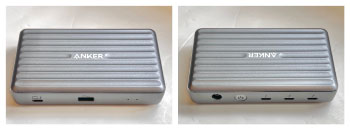 We put that to the test by connecting the 5430 to an Anker PowerExpand 5-in-1 Thunderbolt 4 Mini Dock, a handy 5 x 3 x 0.75 inch box with three powered USB Type-C downstream ports, a 10Gbit/s USB Type-A port, and an upstream port to connect to the computer that delivers 40 gbit/s data transfer, dual display support, and up to 85 watt of charging power. We put that to the test by connecting the 5430 to an Anker PowerExpand 5-in-1 Thunderbolt 4 Mini Dock, a handy 5 x 3 x 0.75 inch box with three powered USB Type-C downstream ports, a 10Gbit/s USB Type-A port, and an upstream port to connect to the computer that delivers 40 gbit/s data transfer, dual display support, and up to 85 watt of charging power.
We tried the Anker dock with the 5430 and here's what we could do:
- Drive TWO extra screens via USB Type-C or HDMI cables
- Plug in USB docks
- Plug in USB keys
- Power and use an external DVD reader
- Connect mice and keyboards either through dock Type-A or Type-C ports
- Charges phones and tablets
- Upstream-charge the laptop
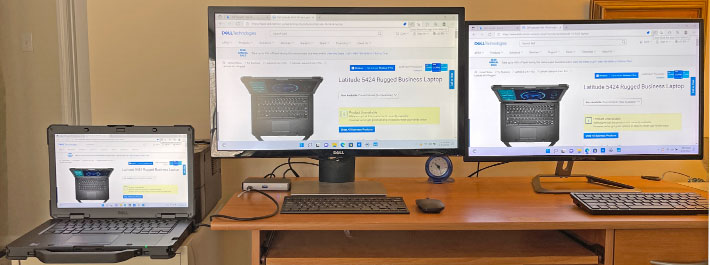
As far as upstream charging goes, the 5430 recognized our Anker 5-in-1 Thunderbolt 4 dock, which can provide up to 85 watts of charging power, as a power supply. The dock started charging the 5430 at a charge rate of up to about 20 watts.
We then connected the 5430 to our larger Anker Thunderbolt 4 12-in-1 dock that can supply 90 watts of upstream charging power. The 7330 recognized it as a power source and began charging at up to about 25 watts. With both Anker docks, the Windows power popup showed remaining charging time until full.
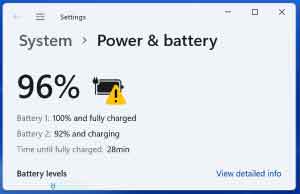 We also tried Thunderbolt upstream charging with a 30 watt Apple MacBook Air USB-C power supply. That one was also acknowledged, albeit with a "slow charger" message. The 5430 charged at a six watt rate, about a quarter of the rate with which it charges with its own power brick or one of our Thunderbolt 4 docks. We also tried Thunderbolt upstream charging with a 30 watt Apple MacBook Air USB-C power supply. That one was also acknowledged, albeit with a "slow charger" message. The 5430 charged at a six watt rate, about a quarter of the rate with which it charges with its own power brick or one of our Thunderbolt 4 docks.
The Dell even worked with a 20 watt iPhone USB charger, though a pop-up suggested the 5430 really preferred to have 27 watt charging or better. Still, it's good to know that if you find yourself in the field somewhere you may be able to charge this Dell laptop with just about any USB charger.
A couple of comments: Note that the Dell 5430 does not have a conventional power jack. Charging is via powered USB-C port. And also note that the power negotiation between Thunderbolt 4/USB-C charging takes a bit of time. In our testing, the power negotiation between the 5430 and whatever power supply we used took about 60 seconds.
We consider the upstream charging capability of Thunderbolt 4 a valuable feature because, theoretically, it allows charging a laptop with pretty much any USB charger. As is, there may be limitations, and customers interested in upstream charging should always make sure their chargers or docks are supported. As is, the Dell 5430 worked better with a variety of chargers than most.
Semi-rugged vs fully rugged Dell Latitude
Most current and potential Dell customers interested in these two new rugged Dell Latitude laptops will probably ask themselves whether they should get the 5430 or the 7330 that was introduced at the same time. Generally, deciding between a semi-rugged and a fully rugged machine is almost a no-brainer. Not so much here.
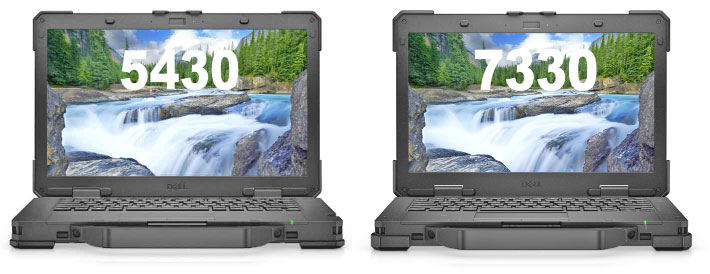
That's because the two laptops look so much alike. Same type of design, same color scheme, same keyboard, pretty much the same size, and no great weight difference. Connectivity is virtually identical, with the machines having the same type and number of ports. RAM and storage are the same. And the available processors are the same. Both have fans. And in our extensive benchmark testing, both perform very much the same.
And yet, one starts at US$1,700, the other at US$4,100. The price gap closes a bit when it comes to nicely equipped machines with the top processor. Our heavily optioned semi-rugged 5430 clocked in at $3,874, more than twice the starting price, whereas our similarly-specced review 7330 came in at $5,577 — hefty but a significantly lesser increase over the base price than with the 5430. The reason for most of the steeper increase in the 5430 is the $747 extra for the 1100 nits outdoor-viewable touch screen over the default 400 nits non-touch display.
If we add that $747 for the bight touch screen to the starting price of the 5430, the resulting $2,447 is still $1,653 less than the starting price of the 7330. That, then, is the cost of full ruggedness.
It may seem steep given virtually identical functionality and performance, but it's justified. The machines may look the same, but the 7330's case is designed very differently, with meticulous emphasis on structural integrity upon impact, as well as making sure that, no matter what, dust and liquids won't get inside the unit.
And that comes at a price. Many customers may decide that the cheaper 5530 is tough enough for their requirements and usage scenarios. For other customers, semi-rugged simply isn't rugged enough. Potentially losing machines in action isn't worth the savings compared to the fully rugged 7330. And that is why Dell makes both.
Oh, and there is another era where the 7330 outshines the 5430. It looks like Dell assumed that the fully rugged machine will spend a higher percentage of its time out there in the field doing demanding work, whereas the semi-rugged machine may see more office duty. Why do we think that? Because whereas when plugged-in the two machines run neck-on-neck in all of our benchmarks, when on battery the 7330 wins every single battle.
Security
Advanced security has become mandatory for laptops, and especially those likely to be used in enterprise, government and other secure environments. For that the Dell 5430 offers several levels of hardware and software security to prevent unauthorized access as well as theft. Among those are multifactor authentication via passwords, fingerprint reader, contact or contactless Smart Card readers, an IR camera option, as well as Dell's own security tools, data protection/encryption, Dell backup and recovery, and more.
Our system included Intel Trusted Platform Module (TPM) 2.0 hardware security for enhanced boot process integrity, and to create and manage computer-generated digital certificates. Combined with Windows 10/11 security, it can encrypt biometric data. In addition, TPM can be used to create certificates that can be used to:
- Send and receive secure email,
- Set up the browser for client identification,
- Sign Word macros,
- Encrypt individual files or entire folders, and
- Create secure network connections.
Fingerprint registration software works with the Dell 5430's optional fingerprint scanner that uses capacitive technology so users can just place their finger on the scanner(which is also the power button) rather than swiping.
All of this can get pretty involved. Some users may never implement TPM, fingerprint scanning or even passwords, whereas others may be set up in accordance with their company's IT security procedures, or they may configure an individual system for maximum security.
Over all this, don't forget physical security and get a Kensington locking cable to use with the Kensington slot on the backside of the unit. It is inexpensive insurance against theft.
Additionally, depending on the processor, Dell 5430 Rugged laptops can be configured with Intel vPro, a set of technologies to remotely access and control computers securely. And there's Dell ControlVault, a hardware-based security solution that provides a secure bank that stores passwords, biometric templates, and security codes within the firmware, and also installs pertinent drivers and firmware.
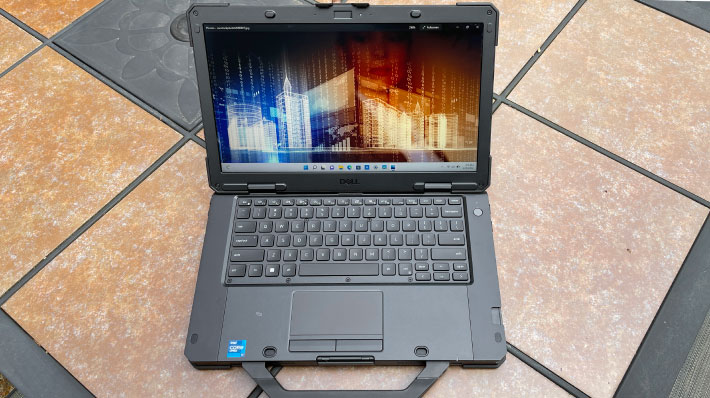
Docking and vehicle mounting
Semi-rugged and fully rugged notebooks are often used in vehicles. To that extent, several mounting system specialists offer docks and cradles for Dell's rugged laptops. The 5430 has separate antenna pass-throughs for GPS, WLAN and WWAN. These may be supported by vehicle docks to make roof-mount antennae possible. A set of pogo docking pins on the bottom of the laptop allow the docks to provide port duplication and additional I/O functionality. These can be mounted in numerous ways, using the dock manufacturers' solutions or the vast variety of RAM ball and joint components.

As of this writing (mid-March 2022), Gamber Johnson (above left) offered a $85 retrofit hook kit designed to modify their previous version docking station to accommodate the new Dell Latitude 5430 Rugged and 7330 Rugged Extreme. Those who have Gamber Johnson laptop cradles or laptop docking stations for the older Dell Latitude 14 Rugged and 14 Rugged Extreme can therefore use their existing cradles when they upgrade to Dell's new rugged machines.
Havis (above center) offers a rugged cradle for the 5430 and 7330 as well as a docking station with standard port or advanced port replication. These, too, seem to require an adaptor kit.
Precision Mounting Technologies (above right) likewise offers a docking station that works with the Dell 5530 and 7330.
Ruggedness
How tough and rugged is Dell's Latitude 5430 Rugged? As stated earlier, it gets a bit confusing here because while the machine is called the Latitude 14 Rugged, it is really a semi-rugged machine. "Semi-rugged" is a rather vague term, something between Dell's standard business laptops and the also new super-tough Latitude 7330 Rugged Extreme.
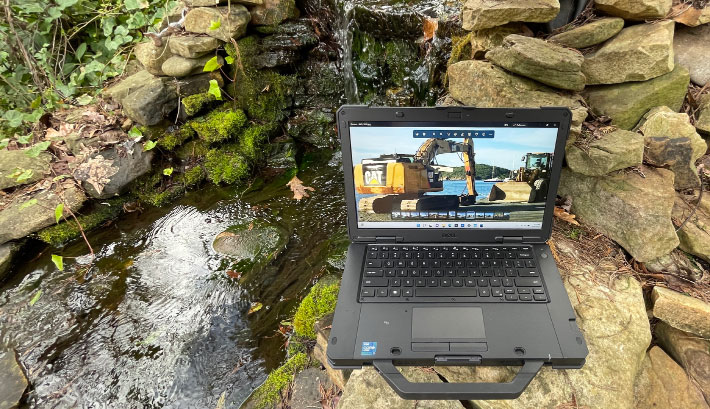
The most likely hazard any laptop is going to encounter is getting dropped. In MIL-STD-810H testing, Dell literature says a 5430 laptop survived 26 three-feet drops while operating. That means a fall from a desk won't faze it whereas such a mishap can kill a lesser laptop. Historically, drop testing has been conducted in accordance with the procedures described in United States military standards. Drops are from a height of 48 inches onto 2-inch plywood over concrete. The machine is then dropped four to six times with the display closed and unit turned off. After each drop, the machine must be able to boot. The relevance of the 4-foot drop is this: when you walk around with a notebook under your arm and you drop it, that's about three feet. 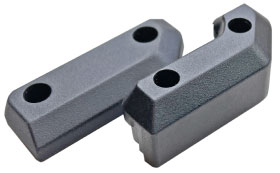 But when you drop it while using it standing up — which almost inevitably happens at some point — that's four feet. We think rugged laptops ought to be certified for four feet, not three. The picture to the right shows the 5430 (left) and 7330 (right) protective bumpers. But when you drop it while using it standing up — which almost inevitably happens at some point — that's four feet. We think rugged laptops ought to be certified for four feet, not three. The picture to the right shows the 5430 (left) and 7330 (right) protective bumpers.
Along those lines, a question comes up with both the 5430 and the 7330. Both machines' protective corner bumpers are screwed on. They could very easily be replaced by optional heftier bumpers that would instantly provide a lot of extra protection. But no such option is available.
The second important ruggedness consideration is the ability to keep solids and liquids from getting into the machine. That's generally where the Ingress Protection rating comes in. And it's an area where semi-ruggeds differ most from fully ruggeds. Consumer laptops aren't sealed at all. Semi-ruggeds like the 5430 provide more protection. The 5430 Rugged carries an IP53 rating, where the "5" means the device is protected against dust, and the "3" that it's also protected against direct sprays of water at up to 60 degree angles from vertical. So it can handle not only the accidental spill but also a good bit of rain and worse. This is a welcome change from the older 5420 that only carried IP52 sealing.
An important requirement of semi-ruggeds is that they continue to perform at a high level when it's very hot or very cold. The Latitude 5430 Rugged's operating temperature range is -20 to 145 degrees Fahrenheit. That's very impressive for a machine classified as semi-rugged, and Dell reps say the machine can maintain full performance over the entire range.
What baffles a bit is the dearth of ruggedness information about the 5430. Even the small print only generally refers to MIL-STD-810H testing for "blowing dust, vibration, functional shock, humidity, altitude, thermal extremes." We know that Dell does extensive ruggedness testing (we've seen it and there's a nice new video about it), but we've been unable to locate detailed ruggedness testing documentation even within Dell's very extensive online product support information.
So things are a bit mixed here. The 5430 is obviously an very well made machine. It's clearly tough, and the supplied ruggedness specs are what we'd expect from a modern semi-rugged. But these machines cost a lot more than standard consumer and customers specifically pay more because they need a ruggedized product. Detailed ruggedness specs that answer all customers' ruggedness questions should be easily available.
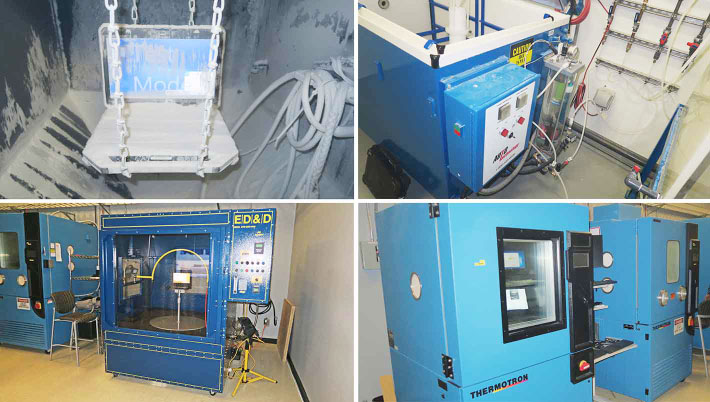
Bottom line: Dell Latitude 5430 Rugged
As standard personal and business laptops get ever thinner and glitzier, there's an increasing demand — particularly in public service and the enterprise — for something that doesn't scratch or break as easily, and provides that extra protection without the high cost of fully rugged gear. That's where "semi-ruggeds" come in. And with the new Latitude 5430 Rugged, Dell offers a modern, powerful and very convincing semi-rugged laptop.
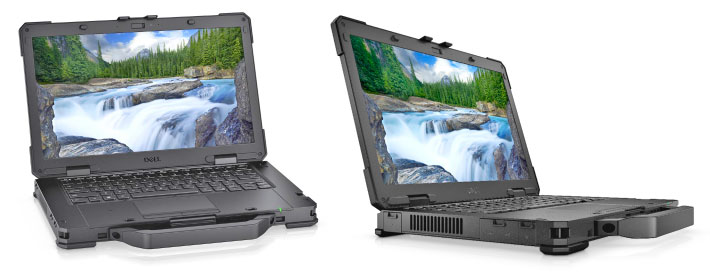
With a remarkably compact footprint of 13.4 x 8.7 inches, less than an inch and a third thick, and starting out at just 4.35 pounds, customers get a state-of-the-art computing tool perfect for when a regular laptop just isn't tough enough. The 5G-capable and Intel 11th generation Core processor-powered 5430 has a very reasonable starting price (US$1,700), but adding desirable options can quickly boost the price. But this is a powerful, state-of-the-art and very well made machine that does just about everything right. Equipped with two Thunderbolt 4 USB-C ports, there's little this Dell machine cannot connect to (or getting charged by). The full HD multi-touch display is bright and vibrant, the carry handle just right, and up to 105 watt-hour of battery capacity make for excellent battery life.
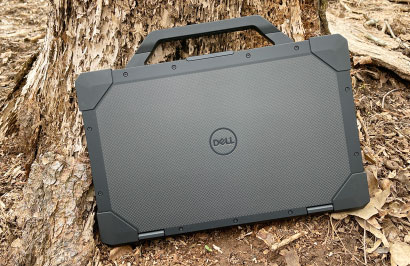
Panasonic, Getac, Durabook and others all offer semi-ruggeds. As of late, there's been an "arms race" with competitors leap-frogging each other with new features and higher performance. With the new Latitude 5430 Rugged, Dell is once again positioned at the leading edge in terms of technology, and the 5430 is a bit lighter and more compact than its primary competition.
Dell, of course, is also a world-leading provider of commercial PCs, which gives them an edge in large scale production experience and also with enterprises that like to one-stop shop. In addition, there's Dell's Global Command Center that stays on top of well over 100 million supported systems, millions and millions of annual dispatches and 500+ same day parts centers in over 160 countries, providing 24/7 support in 50+ languages.
Between that, Dell's solid commitment to the rugged space, and the machine's impressive design, up-to-date technology and specs, this new semi-rugged notebook is certain to be a strong competitor. -- Conrad H. Blickenstorfer, March 2022
|
Dell Latitude 5430 Rugged notebook specs
|
| Type |
Semi-rugged notebook
|
| Introduced |
Introduced October 2021, full review March 2022
|
| Processor |
Intel Core i7-1185G7 (as tested)
Intel Core i5-1145G7
Intel Core i5-1135G7
|
| Max CPU clock speed |
i7-1185G7: 4.80 GHz
i5-1145G7: 4.40 GHz
i5-1135G7: 4,20 GHz
|
| CPU Smart Cache |
i7-1185G7: 12MB
i5-1145G7: 8MB
i5-1135G7: 8MB
|
| Thermal Design Power |
12/28 watts (all)
|
| Graphics |
Intel Iris Xe, optional NVIDIA T500, 4GB GDDR6 discrete graphic controller
|
| OS |
Windows 11
|
| Memory |
Up to 32GB dual-channel DDR4 3200MHz in two DIMM slots |
| Display |
14.0-inch/1920 x 1080 pixel TFT with semi-matte (????) surface, anti-glare, non-touch, 400 nits; capacitive multi-touch, 1,000 nits (965 as tested) |
| Digitizer |
Capacitive multi-touch technology (with sunlight-readable display option) |
| Keyboard |
82-key full-scale island-style keyboard; optional: RGB backlight, rubberized RGB backlit keyboard.
|
| Storage |
Up to 1TB M.2 2230 PCIe NVMe SSD, Class 35
Up to 2TB M.2 2280 PCIe NVMe SSD, Class 40
512GB M.2 2280 PCIe NVMe SSD, self-encrypting, Class 40
|
| Expansion slots |
1 x MicroSD Card, optional Smart Card reader
|
| Media Bay |
1 x Micro SD Card, 1 x Nano SIM card; optional Smart card reader, Contactless Smart card reader
|
| Housing |
Magnesium-aluminum
|
| Size |
13.38 x 8.66 x 1.32 inches (340 x 220 x 34 mm)
|
| Weight |
From 4.35 lbs. (1.97 kg) with a single 3-cell battery, no handle; ; weight as tested with handle and two batteries 5.44 lbs (2.47 kg)
|
| Operating temperature |
-20° to 145° Fahrenheit (-29° to 63° C) |
| Ingress protection |
IP53, splash-resistant keyboard
|
| Drop |
3-foot drop
|
| Humidity |
95% RH, non-condensing
|
| Other environmental |
Vibration resistant
|
| Power |
3-cell 53.5 Whr Li-Ion battery, optional second 3-cell 53.5 Whr Li-Ion battery supporting hot-swap
|
| Security |
Cable lock slot, Optional Security includes: Fingerprint reader, Contactless or Contacted SmartCard reader, TPM 2.0, ControlVault advanced authentication, Dell Security Tools, Dell Data Protection | Encryption, NIST SP800-147 secure platform, Dell Backup and Recovery
|
| Camera |
Optional: HD or FHD/IR video front webcam with privacy shutter
|
| Interface |
1 x USB 3.2 Gen 1
1 x USB 3.2 Gen 1 with Power
1 x TB4/USB 3.2 Gen 2 Type-C with Power
1 x RJ45 Ethernet
1 x HDMI 2.0
1 x RS232 serial
1 x headphone & microphone
Opt. 1 x TB4/USB 3.2 Gen 2 Type-C with Power
Opt. I/O bay with RJ-45 OR USB Type-A OR native RS232 OR Fischer USB 3.0
|
| Wireless |
Intel AX210 2x2 MIMO OR
Wi-Fi 6E 802.11ax with opt. Bluetooth; Opt. Qualcomm SDX20 4G LTE or SDX55 5G, opt. u-blox GPS
|
| Price |
Starting at just over $1,700 USD |
| Contact |
Latitude 5430 Rugged web page |
| Contact |
Latitude 5430 Rugged spec sheet (PDF) |
| Warranty |
Limited Hardware Warranty Standard 3 year Mail-in Service after Remote Diagnosis,
optional 3-5 year Dell ProSupport & ProSupport Plus contracts and optional Next-Business-Day Service available, optional 3-5 year Accidental Damage Service
|
(copyright 2022 RuggedPCReview.com)
|
|
|
